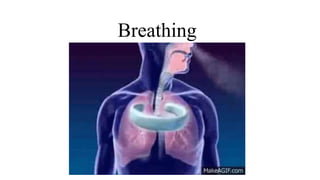
breathing.pptx
- 1. Breathing
- 2. Learning Objectives In this laboratory, you will 1. record breathing movements with a respiratory belt transducer fastened around the abdomen. 2. investigate various aspects of breathing, including the ability to hold the breath, hyperventilation, re-breathing, and the relation between breathing and heart rate.
- 3. Four respiration processes • Breathing (ventilation): air into and out of the lung. 2 parts – inspiration (breathing in ) and expiration (breathing out). • External respiration: gas exchange between air and blood. • Internal respiration: gas exchange between blood and tissue. • Cellular respiration: oxygen use to produce ATP, carbon dioxide as waste.
- 4. BREATHING INVOLVES TWO PROCESSES • Breathe out •The diaphragm expand and relax •Volume in the thoracic cavity decreased •The lungs compress •Air pressure in the lungs increased •Air rush out of the lungs •Breathe in •The diaphragm contracts and flattens Volume in the thoracic cavity increased •The lungs expand •Air pressure in the lungs decreased •The difference in air pressure causes air to rush into the lungs INHALATION EXHALATION
- 5. Ventilation External respiration: gas exchange • Flow of gases between alveolar air and blood in pulmonary circulation. • Diffusion of O2 and CO2 in lungs depends on relative concentrations or partial pressures of gases • Movement of each gas always occurs from a high pressure area to low-pressure area • Partial pressure (PO2, PCO2) is the concentration of a gas in a mixture. • Partial pressure of O2 in arterial blood is expressed as PaO2
- 6. • Each gas in a mixture moves or diffuses according to its own partial pressure gradient and independent of other gases (Dalton’s law) • O2 diffuses from alveolar air, an area of a high concentration of O2, to the blood in pulmonary capillary, has low concentration of O2 , until concentrations become equal • CO2 diffuses out of pulmonary capillary into alveolar air depending on its relative concentrations
- 7. RESPIRATORY MUSCLES Diaphragm, intercostal muscles and the other accessory respiratory muscles work in co-ordination for normal breathing under central controller.
- 8. Respiratory areas in brainstem Medullary respiratory center • Dorsal groups stimulate the diaphragm • Ventral groups stimulate the intercostal and abdominal muscles Pontine respiratory center (pneumataxic) respiratory group Involved with switching between inspiration and expiration Apneustic center of the lower pons appears to promote inhalation by a constant stimulation of the neurons in the medulla oblongata.
- 10. Chemical Mechanism: • Chemoreceptors: • They are the receptors which give response to change in the chemical constituents of blood like.. • A. Hypoxia O2 • B. Hypercapnea CO2 • C. Increased hydrogen ions concentration (decreased blood pH) • Chemoreceptors are classified into two groups: • 1. Central chemoreceptors • 2. Peripheral chemoreceptors
- 11. Central chemoreceptors • They are situated in deeper part of medulla oblongata, close to the dorsal group of neurons. • This area is known as chemosensitive area and neurons are called as chemoreceptors. • They are very sensitive to increase in hydrogen ion concentration. • Hydrogen ion cannot cross the blood brain barrier and blood cerebrospinal fluid barrier
- 12. Peripheral chemoreceptors • The receptors are present in peripheral portions of the body that’s why called as peripheral chemoreceptors. • They are very sensitive to reduction in partial pressure of oxygen. • Whenever, the partial pressure of oxygen decreases these chemoreceptors become activated and send impulses to inspiratory center and stimulate them. • Thereby increases rate and force of respiration and rectifies the lack of oxygen.
- 13. Setup 1. Fasten the respiratory belt around the abdomen of a volunteer 2. Connect the plug on the respiratory belt transducer cable to Input 1 on the front of the PowerLab.
- 14. Exercise 1: Normal respiration • In this exercise, you will record normal and rapid breathing, and examine the effects of holding your breath after inhaling and after exhaling. 2-3 minutes 2-3 minutes M M cursor cursor Few seconds
- 15. Exercise 2: Hyperventilation • In this exercise, you will record the effect of voluntary hyperventilation on breath-holding and the recovery of normal breathing rhythm. 2-3 minutes as long as possible. 30 seconds 2-3 minutes 2-3 minutes 2-3 minutes 30 seconds select Breath Rate breathing select
- 16. Exercise 3: The effect of rebreathing • In this exercise, you will observe the effect of rebreathing exhaled gases. You will need to obtain a medium-sized paper bag. When re- breathing, the volunteer should place this so that it covers the nose and mouth and forms a tight seal.
- 17. 2-3 minutes 60 seconds Continue recording for 60 seconds.
- 18. Exercise 4: Breathing and heart rate • In this exercise, you will record and examine the effect of breath-holding on heart rate. • Procedure • Leave the respiratory belt fastened around the abdomen of the volunteer. • 2. Connect the finger pulse transducer to Input 2 on the PowerLab. • 3. Place the pressure pad of the finger pulse transducer against the tip of the middle finger of either hand of the volunteer. Use the Velcro strap to attach it firmly - neither loose nor tight. • 4. Ensure that the person sits quietly with his or her hands resting in their lap, or on a bench, to minimize transducer movements.